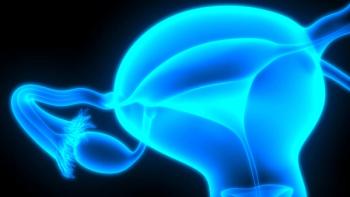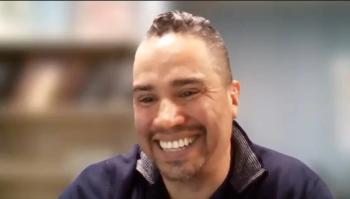
Oncology NEWS International
- Oncology NEWS International Vol 7 No 1
- Volume 7
- Issue 1
Re-treatment With Rituximab Monoclonal Antibody Safe, Effective
ASH-Rituximab (Rituxan), a chimeric anti-CD20 monoclonal antibody, recently received FDA approval for use in patients with relapsed or refractory follicular or low-grade, CD20-positive, B-cell non-Hodgkin’s lymphomas . Poster presentations at the annual meeting of the American Society of Hematology in San Diego suggest that:
ASHRituximab (Rituxan), a chimeric anti-CD20 monoclonal antibody, recently received FDA approval for use in patients with relapsed or refractory follicular or low-grade, CD20-positive, B-cell non-Hodgkins
- The agent may be used as re-treatment in patients who relapse after an initial response.
- A higher total rituximab dose might be useful in certain subpopulations and deserves further study.
- Rituximab can produce responses in mantle cell lymphoma patients refractory to doxorubicin.
Christine A. White, MD, senior director of oncology and hematology at IDEC Pharmaceuticals, the manufacturer of rituximab, discussed with Oncology News International the two posters presentations involving patients re-treated with rituximab and those treated with more than four doses.
Responses Seen With Re-treatment
In the re-treatment trial, presented by Thomas Davis, MD, of Stanford University, 56 patients who had had a partial or complete response on a prior rituximab trial were re-treated upon relapse with the same dose (375 mg/m2 for four doses). In this report of interim results, 36 patients were evaluated for efficacy.
We found no increased risk of side effects with re-treatment, no increased incidence of human anti-chimeric antibody (HACA), and a very good overall response rate of 44% (11% complete response and 33% partial response), Dr. White said. We have three patients who have gone on to a third rituximab treatment. Two of these three patients achieved a partial response with a third treatment, and one had stable disease.
Eight Doses Instead of Four
In the pivotal studies, patients received 375 mg/m2 of rituximab for four doses. In a pilot study headed by Lawrence Piro, MD, formerly with the Scripps Clinic and now with Salick, 37 patients received eight doses of rituximab, 375 mg/m2, to see if a higher total dose could produce higher response rates in general or in particular subpopulations.
Although the overall response rate of 60% in evaluable patients was higher than the 48% seen in the pivotal trials, the difference was not significant. The investigators specifically looked at the International Working Formulation type A (IWF-A) patients because those are patients who in our previous experience we knew had lower serum levels of rituximab and somewhat lower response rates, Dr. White said.
There were only seven patients in this group, and the response rate, using strict criteria, was not significantly different from that observed in this group of patients in the pivotal study. However, we did again see that serum drug levels were lower in the IWF type A patient, Dr. White said.
Although this study did not an-swer the question of whether certain subgroups of patients, IWF type A or maybe patients with exceptionally bulky disease, could benefit from more than the four doses, subsequent studies using other dosages and schedules are going to address this question, Dr. White said.
Refractory Mantle Cell Lymphoma
In the first trial of rituximab in diffuse large B-cell or mantle cell lymphoma, including patients refractory to doxorubicin, the overall objective response rate was 31%, Bertrand Coiffier, MD, of the Centre Hospitalier, Lyon, France, said in his poster presentation.
This open-label, multicenter phase II trial involved 54 patients with relapsing or refractory aggressive lymphoma who had received no more than two prior chemotherapy regimens or, if older than age 60, a de novo aggressive lymphoma. Patients were randomized to receive one of two doses of rituximab: 375 mg/m2 once weekly for 8 weeks or 375 mg/m2 as the first dose followed by 500 mg/m2 once weekly for 7 weeks.
On an intent to treat basis, complete and partial response rates were 9% and 22%, respectively. There were no significant differences between the two doses.
In some categories of patient, the response rate was above 40%, Dr. Coiffier said. Factors associated with a higher likelihood of response were response to previous treatment or lack of previous treatment, diffuse large-cell lymphoma histology, low tumor burden, and a good performance status. For responding patients, estimated median time to progression is longer than 8 months, he said.
The next step in these patients is to combine rituximab with chemotherapy such as CHOP. There may be a synergistic effect that increases the efficacy of CHOP, Dr. Coiffier said.
Articles in this issue
almost 28 years ago
Interferon Improves Survival In CML: 10-Year Follow-upalmost 28 years ago
Update on Breast Cancer Chemoprevention Trialsalmost 28 years ago
Topotecan Plus Cytarabine Promising in MDSalmost 28 years ago
Update of Letrozole Pivotal Trials in Advanced Breast Canceralmost 28 years ago
Arguments Against Mammograms for Age 40-49 Refutedalmost 28 years ago
Proton Beam Therapy Appears Safer than Prostatectomy, X-raysalmost 28 years ago
RT Effective Palliation for Malignant Melanomaalmost 28 years ago
Metastatic Breast Cancer Responds to Docetaxel, Doxorubicin, Cytoxanalmost 28 years ago
Prevention of Breast Cancer Begins With Public Health Education on RisksNewsletter
Stay up to date on recent advances in the multidisciplinary approach to cancer.


















































































